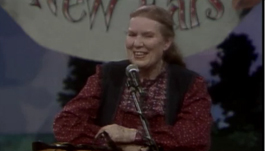Teachers' Domain - Digital Media for the Classroom and Professional Development
User: Preview



Folksinger Jean Ritchie performs the Appalachian tune “Shady Grove,” a traditional song she learned from her family. Then she performs “Bandyrowe,” a song for which she made up verses to help get her two sons to sleep when they were very young. Ritchie accompanies herself on the lap dulcimer.
Find additional arts resources for your classroom at the KET Arts Toolkit website.
Jean Ritchie was born and raised in Viper, Kentucky, in the heart of the southern Appalachian Mountains. According to local history, her ancestors came to America from Scotland in 1768, moving into the Kentucky wilderness a few years later and settling near what is now the Carr’s Fork of Troublesome Creek. She grew up in the 1920s and ’30s in a family that farmed the rugged hillsides and entertained itself with the old ballads, love plaints, and play-party games (dances) handed down from their Scottish, Irish, and English ancestors.
Many of the traditional songs we think of as Appalachian were handed down through the Ritchie family. Jean Ritchie has performed the traditional songs and her own songs around the world. She has also helped preserve Appalachian traditions in music and dance that might otherwise have been forgotten.
The ballad form is a popular song form that came to America primarily from Europe. The ballad is basically a story told in song. It can be about almost anything—love, of course, but also legends, ghosts, death, betrayal, and mistaken identity. Through English ballads, the less-educated “folk” could teach stories and legends from their culture and history. “The Cuckoo” is a good example of a ballad that originated in England and underwent many adaptations in Appalachia. “Shady Grove,” on the other hand, was probably created in America as an Appalachian ballad. This is the Ritchie family version, adapted and arranged by Jean Ritchie.
Here’s what she says about the song: “My dad, Balis Ritchie, was born on Lott’s Creek in Knott County in southeastern Kentucky in 1869! When he was about seven years old, he heard his first fiddle played. A man, a friend of the teacher, came in one day from Virginia and played a tune the children knew to sing, as a song, but Dad said when the fiddle started to play, that tune took off like the devil was after it. He vowed he’d play the fiddle when he grew up, and he did, but he got a dulcimer before he got a fiddle, and thought the tune sounded pretty good on that too.”
Jean Ritchie plays the Appalachian lap dulcimer, as her father did before her. The instrument is probably a descendant of the German Scheitholt, the Scandinavian langliek, and the French epinette de Vosges, brought to America by immigrants sometime in the 18th century. The lap dulcimer has three or four strings and a fretted fingerboard and is played with a plectrum of some sort. In the past, this plectrum was often a feather, but today it is most often a plastic pick.
 Loading Standards
Loading Standards